You know a good prepper pantry just by seeing the organizational skills of the owner. My earthquake-proof shelving is stocked full of enough food to last my family years without resources.
It didn’t get that way overnight; it takes years of trial, error, and research to get your food storage ready for disaster.
A well-organized prepper pantry is so satisfying to look at. By grouping different varieties of non-perishable foods, you can optimize their shelf life, saving you money and resources down the road.
Sometimes, certain foods should not be stored with other foods to keep them fresh. No matter what you are storing, the food stock should be kept in a cool, dark place such as a basement.
Here are 10 foods you should never store together in your non-perishable food stock.
Canned Foods
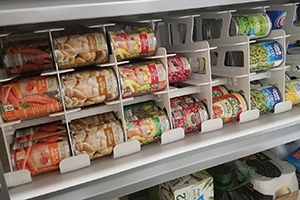
I keep all of my canned foods separate from the rest of the stock. This is because my canned goods are located on a sloped shelf.
This way, I can easily rotate my cans by ¼ turn every few months, I can easily see if any cans are damaged, and I can consume the oldest cans before their expiration date.
No can will get left behind and any damaged cans can be discarded.
Cans should also be kept away from any potential moisture. Moisture causes corrosion, which can then penetrate the food inside, making it inedible.
If you are rotating your cans now and then, you will notice before corrosion gets out of hand.
Related: How to Build Your Own Wall Hanging Can Rotator
Food in Glass Jars
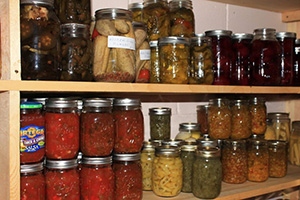 Glass jars are not my first preference in food storage, although they do offer some tasty food when compared to canned.
Glass jars are not my first preference in food storage, although they do offer some tasty food when compared to canned.
The bottom line is that glass can break, and you do not want glass shards around any bags or items that glass could penetrate.
Keep your glass jars tucked away in a location that potential broken glass will not cause harm.
Boxed Foods
Any foods that come in a box, such as flavored rice or macaroni and cheese, should be stored separately from other non-perishable foods.
Any inkling of moisture and these foods could grow mold and become unsafe for you to eat.
Related: How to Keep Moisture and Pests Away from Your Food Stockpile
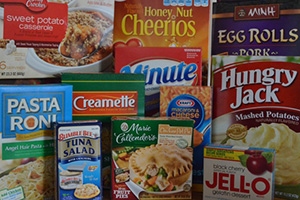
The foods should be rotated out more frequently than canned foods and should be kept on a high shelf away from potential moisture.
Removing the food from the box and storing it in Mylar bags will preserve them for even longer, but still, give the bags their shelf for organization and optimal freshness.
Rice
Rice in particular draws moisture out of the air as it ages, causing it to go bad.
Ever wonder why you put your wet smartphone into rice to draw the moisture out?
This is why! It is imperative to store rice in a vacuum-sealed bag away from any moisture.
Dry Vacuum-Sealed Foods
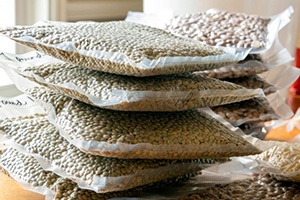
We can all agree that a vacuum-sealer is one of the most important tools for a prepper’s food stock.
When storing my beef jerky, dried beans, barley, and other grains, I keep all dated and labeled dry foods next to each other.
This is to stay organized but it is to also take an extra step in keeping moist foods away from dry foods.
Keep any vulnerable bags far from the glass jars, as broken glass could easily penetrate a vacuum-sealed bag.
Related: How to Dry Can Beans and Rice for 20+ Years Shelf Life
Wet Vacuum-Sealed Foods
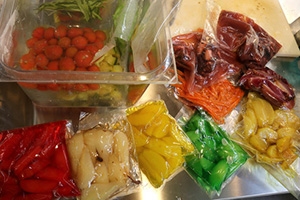
Moisture is not your friend when storing non-perishables. Moist foods are stored separately from dry foods, especially when they are in similar food storage bags.
It’s great for organization and an extra step in keeping moisture away from boxes, cans, and other storage bags.
Flour
Flour can take on some interesting flavors if not stored properly. It absorbs moisture from the air, so airtight storage is a must.
Flour, baking soda, spices, and other baking ingredients are typically kept in airtight fresh-lock containers in a separate location within the food storage.
Sweeteners
Any sweet items that you have stored such as honey or maple syrup, are kept up and away from other items.
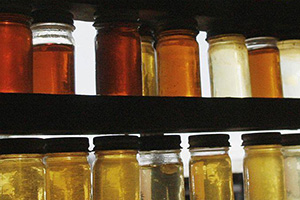
Never store your sweeteners on the ground where insects can easily access them.
This could bring insects to other parts of your storage as well, so store the sweet stuff on the highest shelf that you can, away from easily penetrative boxed foods or food storage bags.
Honey oxidizes metal, so be sure to also keep your honey away from cans and metal brackets.
MREs
Any prepared foods that need next-to-nothing to heat and eat should be stored together, away from the other foods in your stock.
Related: What Happens When You Eat Nothing but MREs
Self-Heating Meals
Temperature and moisture control are so important when storing non-perishables.
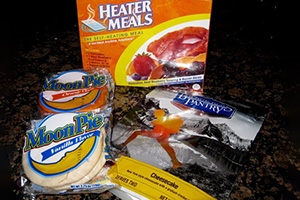
Self-heating meals are foods that come with a heating element. Any potential accidents are unlikely to come from the heating element, but I like to err on the side of caution.
Self-heating meals have their place, away from other foods, just in case the self-heat triggers by accident.
What’s More
As we know, water is the arch-nemesis to so many of our non-perishable foods. However, we will need water storage to survive, whether that comes from large jugs kept in storage or collecting rainwater.
Keep all water far away from every single food on this list. Water and moisture corrode cans, spoil rice, and disintegrate outer food boxes. This is the most integral part of storing food for the long term. If you can store your water in a separate location, that would be optimal.
Having awesome food storage for a disaster is not as easy as throwing things on a shelf in your basement. The organization is key, and I like to keep like-foods close to one another.
Keep water storage far, far away from your non-perishables because moisture can wreak all of your hard work. Keep glass jars and penetrative packaging far away from each other so there are no accidents in case a jar breaks.
Once you get the hang of food storage, you will have a level of newfound security, knowing you can feed your family for years without a grocery store.
You may also like:
 Urbanites Moving To Rural Paradise Ruining It For The Locals
Urbanites Moving To Rural Paradise Ruining It For The Locals
An Insanely Effective Way to Build a 5 Year Food Stockpile (Video)
How to Make The Coolest Wool Boots Ever, Easily
Investing For Preppers – 12 Things That Won’t Lose Value In A Crisis

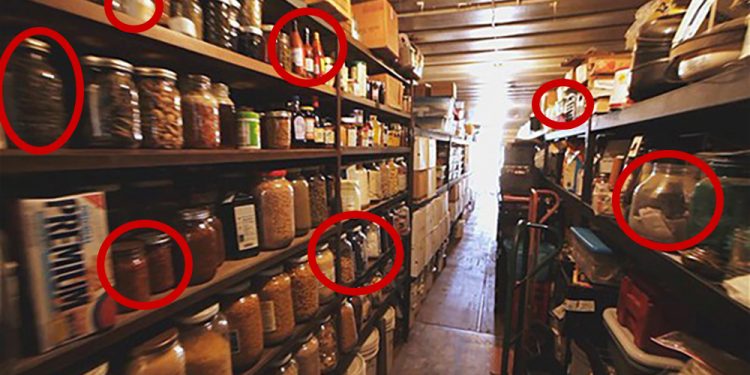













Honey – I am confused on this as you say honey oxidizes metal and should be kept away from cans and metal brackets. I had never heard this before and googled it for confirmation/clarity. What I read says to not store honey IN metal containers becasue of that issue. Is that what you meant? Most of us store honey in plastic or glass containers and our shelving is metal but the honey itself is not making contact with the shelving or cans packed near it, None of the honey I have ever stored in plastic or jars has ever had an impact on my sehlving or anything metal near said containers. Please clairfy. Thanks.
Also, about sweets, I put my canned goods on shelves and the jars are always washed on the outside throughtly before storing them. I am not sure how pests could be attracted to the contents if there is no residue on the non porous containers to start with.
Marti: You should understand what is printed in the articles on this list is not handed down on stone tablets from Mount Sinai. Many times there are errors and many times the author is merely repeating urban legend and does not have practical experience in the matter. Brandi M is one author who frequently writes articles on topic of which she has minimal knowledge as shown by the errors in her articles.
I see that Claude is no longer printing the name of the author and I think that is a big mistake. I give little credence to articles that the author won’t stand behind with his name or at a minimum, a statement of his credentials to write the article. I put far more credence in an article that says,”I have done this particular thing for five years and this is what I have found as a result of my experience.”
The perfect example of that is the book on homesteading by a husband and wife team who have started three separate homesteads in distant rural areas and are contemplating starting over with a fourth homestead. They have been there and done that. They explain why things didn’t work for them and why certain things did work. I only skimmed through the book in order to write a review of it. I didn’t study it as I would were I contemplating homesteading. Even with just a quick review I learned many things about homesteading that were contrary to what I had believed for a long time.
Just a quick for instance. I learned that human wastes can be safely used as fertilizer. I had always believed that they were not suitable for crop fertilization. I also learned what a drag windmill generated electricity is. Strong winds are great, right? Not when they spin your windmill so hard it is in danger of being destroyed and taking a windmill down in a windstorm is both exhilarating and dangerous.
So, if your experience is like mine that honey doesn’t corrode metal jar lids, go with your experience. The author doesn’t support his posit with any personally observed experiences, so one can only gather from our own contrary evidence that he is expressing an urban legend and has no first hand knowledge of what he or she writes. We have no way of knowing what the unknown author has by way of expertise in the topic of which he or she writes. Listen to what Clergylady says. Now there is first hand knowledge. She has actually been there and done it and and is currently there and doing it.
If Clergylady says she does it this way because it works for her, you had better believe she knows exactly what she is talking about.
You might be right about rice, but I have seen rice stored in India in granaries that are nothing more than rice straw made into coils and then circular storage bins. Of course I’m sure rats, mice and monsoon rains do their damage, but the people still keep it this way. Depends on what you have available I guess.
Good article. Just keep as much as possible in its original package an reinforce moisture control with an extra zip loc bag of some kind and put items in plastic bins. Has worked great for me and never any trouble with bugs at all. Stuff stored in this manner since 2011 and counting. Have a folder of all containers numbered from 1- ?? and every item in each container listed so if I die or things get bad we can search for what we are looking for without going through every container. Even bug out bags have lists in them. When you are in disarray because of your circumstances that does not mean you have to be in disarray with your preps. Again, good article and great advice.
I would like to mention that the only safe 100% moisture proof storage is so called tin cans (metal cans with tight fitting lid) or glass bottles with a tight sealed lid. ALL plastics allow moisture to penetrate over time some less than others but all do breath. Your best storage is in large glass jars and large tin can such as pretzel cans, christmas cake pans etc. Each can ca be labeled rice-beans-flour-seasoning etc. This also helps with storage because they can be stacked and much easier to carry than lots of small bags.
Interesting thoughts. The tins and jars should have good sealing material in order to keep out moisture.
Plastic bags with a sufficient metal film (e.g. certain mylar bags) seal out water vapor. Nitrogen flushing can help extend shelf life. Very few materials are able to prevent hydrogen from entering a container (and combining with remaining oxygen to form moisture).
A lot depends on how long the food is to be stored and how quickly it will be used after opening. The tins can also help organize smaller portions of the same ingredient as well as keep out rodents. Rotating stock and testing during good times can help identify issues before they are a significant problem.
Good reminders.
I keep my water storage near the kithen sink. Most canned goods are on stacked bookcases down a hallway and the rest in a little pantry i built to separate the kitchen and livingroom. It’s a small home so storage is hard to come by. Still I try to keep most things separated. 1 cabinet in the pantry has canned meats and fish and one shelf of chili con Carne, he other cabinet has a shelf of seasonings, a shelf of pasta sauces,, a bigger shelf area is coffee, ground, instant, cocoa powder, creamer, and drink mixes. I use a 3 shelf shop cart with the canners on top and baking supplies on the shelves to close up the tiny pantry. (Seasonings I need to work on.) One pantry shelf has seasonings and a storage box in the hall next to the shelves for canned goods, has more seasonings. 2 more stackable containers in the hall have excess medical items in them. Another labeled container in the hall could get all the seasonings together in one area. That would open up a shelf in the pantry. One side of the pantry is tall cabinets with a space in-between for 2 stacks of 3 gal buckets. The end at the wall is two stacked bookcases. The third side is a framed wall with some edible items stacked on the bottom 2×4 and mops, brooms, a dust pan, ect hung in the wall. The bookcases hold freeze dried gal cans. 90 mylar blankets, a bag of flasights and head lamps, an amo box of batteries. Assorted items like a wind up flashlight, small radio, a couple of sets of walki talkies ect. The top of the bookcase and cabinets hold papergoods. The livingroom side of the pantry is 4 tall bookcases facing the livingroom. Next to the cleaning tools on the framed wall is a clear plastic shoe bag. Each section hold vitamins, manicure sets, eyeglasses cases with readers and little repair kits from the dollar store. Extra emery boards that also clean the points on the well pump pressure switch. Lots of handy little things, easy to find. The kitchen side of the pantry has a storage bench i built for my office yearsago, and a little free standing closet. It’s a handy coat closet near the front door. The bench hold bug out bags, my fishing tackle box, some camping items, a tent, and air matresses ect. The wall above the bench has a decorative coat rack and mounts to hold fishing poles. 2 of mine are there. Husbands fishing tackle and poles are in a shop building. It created lots of storage in a little area. And it put camping and bug out things by the front door.
Neither of us can walk far now so I have more bug out items ready to grab and load in the car. A med bag, a food bag, 2 personal bags, a seasonal bag with extra rope. 3, 5 gal water containers would be easy to grab if time permits. I can load the bags in under 3 minutes. Adding camping gear adds another 3 minutes. Adding rabbits and food adds 10 minutes. Adding chickens and ducks in dog crates in the truck bed adds 10-15 more minutes. I have practiced bugging out isn’t a real plan. Husband is getting too fragile now.
Home sweet home, is where we will plan to stay baring fire. We don’t have a fire department here. Just garden hoses and wells.
By the way for those buying food to store, price the #10 cans of freeze dried vegetables often. I found Auguson Farms sliced potatoes for $5.55 per #10 can. A store was going out of business. I bought 3. I’ve purchased other things cheap as well. Many businesses have been closing. Google things to check on. Not by supplier, but by item or brand.
Hmmm. Well, this is what I have from my experience….
Canned food- keep it cool and dry and all is good. I never did rotate the cans, but then I rarely had anything last in my supplies longer than a year. If the cans have recieved any damage while in storage, then it’s not the cans that need to be looked after. They are rodent-proof.
Glass jars are good for home-canned food, and that’s about it. They are rodent-proof, though.
Boxed foods are okay, if you’re gong to keep them a while keep in mind the sauce mixes don’t handle time very well and they’ll go rancid long before the pastas ever will. The boxes are not rodent-proof, but you can store them in a rodent-proof manner. I found that a cage made of 2×2’s and 1/4″ metal hardware cloth works well for the boxed foods you need ready access to. For thos you want to store, the same cage works, but it must be a full cage, i.e. all sides, top & bottom must be secured. Mice are horrible in getting places you think would be impossible! For long-term storage I found that a large ammo can (don’t have mine accessable right now), mine is a knee-high .50 cal BMG can, I put the boxed food in it, then a quarter pound chunk of dry ice, let it fill the can, then close the can. It will still use the remainder, putting the can under pressure, but it kills any potential insects/weevils/whatever. The sauce mixes will still age, though.
White rice is good, brown rice is oily, and the oil goes bad faster. Rice does very well as a food and for moisture control.
Vacuum sealed bags are great, in some cases I’ll double bag. In some instances using the vacuum sealed bags for keeping the boxed meals is ideal. Simply empty the boxes, inspect the ingredients, and put them in the bags minus the cardboard boxes. Keep the sauce mixes sealed. However, I have been told that removing the sauce mixes & putting them in a vacuum sealed bag with white rice works really good. I just never tried that. That is something that takes a few years to experiement with.
Wet Vacuum-Sealed Foods are meant for cool to cold storage. Wet=ideal breeding areas for micros. Bad idea unless it’s in the freezer.
Flour, be careful because of the micros that can make anyone sick.
Same with powdered milk, any powdered foods and sweeteners.
MRE’s, put them in a box and stick it in the corner somewhere and all is good. They are zero threat to anything else.
I cannot comment on the self-heqating meals other than keep them in an environment that does not activate the self-heating componant.
That’s my two cents of experience….
If one shops in grocery stores catering to the Japanese market, one can buy vacuum packed or nitrogen packed rice. I would imagine that stores catering to the Korean and Chinese markets have similar products. That certainly adds to the shelf life of those foods as long as the mylar bag the rice is packed in remains sealed. It is more expensive than a bag of rice from Costco but then you don’t have to do anything to extend its shelf life. Besides buying it in five pound bags allows one to store the rice and open it a little at a time. Five pounds of rice makes a lot of cooked rice.
After the 5 lb bag is opened you now have 4 plus pounds of rice sitting in an unsealed container. Now you have to store all of the left over rice in vacuum sealed containers. I fail to see how your suggestion makes storing 5 lbs of rice any better than just vacuum sealing to begin with.
Vacuum sealing doesn’t get out all of the air, let alone oxygen. Done properly, packing rice in a 75 cent Mylar bag with a 12 cent O2 absorber removes greater than 99.9% of the oxygen, leaving you with 99.9% pure Nitrogen environment – Nitrogen being the gold-standard in replacement gas for packing.
I built my rice storage with 25 pound bags from Sam’s Club, and, to start with I packed them 1 pound at a time into Mylar bags. Later, I switched to 4 lbs in a bag because 4 lbs lasts us a few weeks normally. In good times, the 1 pound lasts two meals or just one meal in a disaster where we would need more calories. I say, “built my rice storage” because it’s been completed for years now. the oldest currently is 2008 as I eat the oldest and replace it new. But mostly I just buy new to eat because the stored rice will last for decades more
It is an easy process to transfer the four plus pounds to 2-liter water bottles. I like seltzer water, so the bottles just need to be dried out. No worry about sugar sticking to the insides to create some kind of unwanted extras in the rice. Put in an oxygen absorber and fill the 2-liter bottle right to the very top. Bang it a couple or more times as you are filling it to remove extra air in the bottle. Ve especially vigilant to bank the jar as you near the top. That makes a pretty good storage device for rice. Place the one of the bottles in the mylar bag the rice originally came in and the other 2-liter bottles in brown paper bags to protect them from light. If you are infested with rodents, store the rice in larger size Mason jars. They do come in bigger sizes than one quart. Or if bigger jars don’t work for you, store the rice in whatever size floats your boat. Again, place the jars in brown paper bags to shield them from light. Stored that way white rice will last longer than you will. I have personally stored brown rice in that manner and if it has turned rancid, then my burned out tastebuds can’t detect the rancidness. If it don’t kill me, and it hasn’t so far, I guess it probably is okay. That is first hand, actually done, practice, not some urban legend with no back-up. Of course, I could be lying about the whole process, but based on my many posts, I think the greater number of readers would accept that I generally know what I post and have done what I said I have done.
As for the other 5 pounds bags of rice I have stored in their nitrogen filled bags, they will be fine until I open them and again transfer the contents. Obviously were my house infested with mice, that situation would not exist. I might store the unopened bags in a large tin as another poster suggested. I have a couple of pretzel cans that I might fit two bags in each. I don’t know. I haven’t tried it. One is in the garage with rope in it. I have made the other into a Faraday cage with fruitcake cans inside it to enhance the Faraday effect.
Flour, Oats, Cereal, and the like should be put in the deep freeze for 4 days to kill off any insect eggs.
THEN quickly place them in an air tight container and let them warm up.
Best to store those anyway in an air tight container.
Freezing doesn’t always work.
I think I have only frozen anything once for preparing for long term storage. My go to is food grade diatomaceous earth (DE). As I understand it this is in many dry foods(i.e. cake mixes, etc.) we buy anyway. I put my grains, flour, beans, etc. in the mylar which is inside a 5 gallon bucket. I put about 1/4 cup DE in around the half way mark and stir it into the food, then once the container is filled I put another 1/4 cup on top and stir that in.DEgoes along way and I’ve not had any insect infestation when I use it as it kills anything that might hatch. Those interested can google this all natural product to decide if it is worth trying.
Crazy: 20 lbs of buckwheat flour, coconut flour, and so on, all went in the freezer for a few weeks. Took it out, put it all in the pantry, and it’s still fine. But, once a bag is opened, it goes in either the fridge or back to the freezer. same with 200 lbs shell corn, 40 in chia, 100 lbs pinto beans (they get used for flour), about 20 lbs mesquite (what’s left from last summer), and so on. Once opened, they get hit with some food grade diatomaceous earth from the farm store. Even packrats stay away from them then. 🙂 niio
Red, your practice protects, somewhat, from bugs in the bag you freeze but it doesn’t protect from bugs that might enter from your pantry. One small flour or grain spill or imperfectly sealed bag (and most retail packers don’t even try to seal their products) and you have an open invitation to more bugs.
I’ve had an infestation of weevils in my pantry and it was a big mess to clean out; everything that could be infested was infested, including unopened bags.
On the other hand, I have an outside shed that, among other things, has wheat that was purchased in buckets, presumably packed with CO2 but I know there are no O2 absorbers as I’ve consumed a few of the buckets. I’ve had these buckets for 25 years and not a sign of infestation so far. The way you can tell is that the buckets will become light as the critters eat the grain. The bucket in my kitchen, this one sealed with only a gamma (screw-on) lid, also has no sign of infestation.
The point is, it’s a gamble. we do the best we can and hope it works. But in 15 years of using O2 absorbers, I’ve never had any infestation in O2 packaged foods. I’ve even had mice infestations that chewed into food that wasn’t properly packed but they completely skipped/missed/ignored the O2/Mylar packed foods.
Dale: so far, safe flying. Some years ago we went thru the problem of infestations. We’re not grain eaters. Grain is usually posole/cornflour mixed with bean flour. Most grain consumed, tho, is rice sourdough, and that’s a once-in-a-while thing. I’ve never had a problem with insects or rodents in cornflour, possibly because of how it’s made, with lye.
Nor do we eat a lot of legumes. Mesquite is probably the number one legume. That, as well, should be frozen for a time to kill weevil eggs. niio
When we buy #10 cans, when using them, most will go either in the freezer or be dried. Also, I saw smaller cans for sale, same product, cheaper per ounce than the 10s. WalMart is bad for that. niio
IIRC DE is like broken glass for mice.
Actually, diatomaceous earth is like broken glass for humans also. You should really wear an N95 mask when handling D.E. inhaling it will cause silicosis which can give you breathing problems as bad as black lung. It sneaks up on you. You don’t realize you have been affected until suddenly one day, any kind of activity leaves you gasping for air. Pretty soon you are dragging an oxygen bottle every where you go.
That’s right, LCC. Mixing diatomaceous earth into your food is slow suicide.
There is a lot to be gained from modern science. Today we have oxygen absorbers and freezers. I don’t freeze mine before packing with the O2 absorbers but if someone wanted to take the extra step, extra precaution, that would be the way to go.
DE is not safe for human consumption. It always amazes me how much stupid shit people do because they read it on the Internet – usually from some random youtube video, not from any scientific or truly educational site.
Dale: yes, up to a point. DE can be used, but very rarely. Used as a medicinal, it’s in general safe. BTW, LCC, quite a lot of broken glass is allowed by Dept. of Ag in our food and is called safe–but for who?!
Food Grade is mixed with grain because it kills insects, but also deters rodents and birds for reason you and LCC stated. But, it still should be washed off!
Regular DE goes on garden plants, but only if nature isn’t doing her job. This seems to be the year of a sphid, but lizards are out now, patrolling, so the DE can be put away. niio
Red, you are right; there is an awful lot of anecdotal data supporting consumption of DE. I don’t believe any of it. Here’s some less-anecdotal, at least partially-scientific, arguments against it. https://sciencebasedmedicine.org/diatomaceous-earth-no-thank-you/
I don’t think you can offer science to back up its being safe. Even if I can also not produce peer-reviewed science saying it’s not safe, I will err on the side of not consuming it.
Dale: Nothing is safe and it never was. We are not disagreeing here, but I caution you about spoilers. If you know scientists, then you see why every time a discovery is made, there are a half-dozen ready to just aboard screaming no-no-no! Look what happened to Jack Horner when he said some dinos had bird-like attributes, and what happened to him for helping Dr. Schweitzer.
Anything new to the superstitious is the latest, greatest superfood. Not being a fan of pushers, legal or illegal, I tend to ignore both sides till reality comes out.
Outside of the garden, I like it only as protection of grain, and as I said, we’re not big on grain. It washes away easily. when you cook rice, you’re supposed to wash it well, first, because DE is used to keep off insects and rodents. And, I’d rather that than with they used to use, DDT. niio